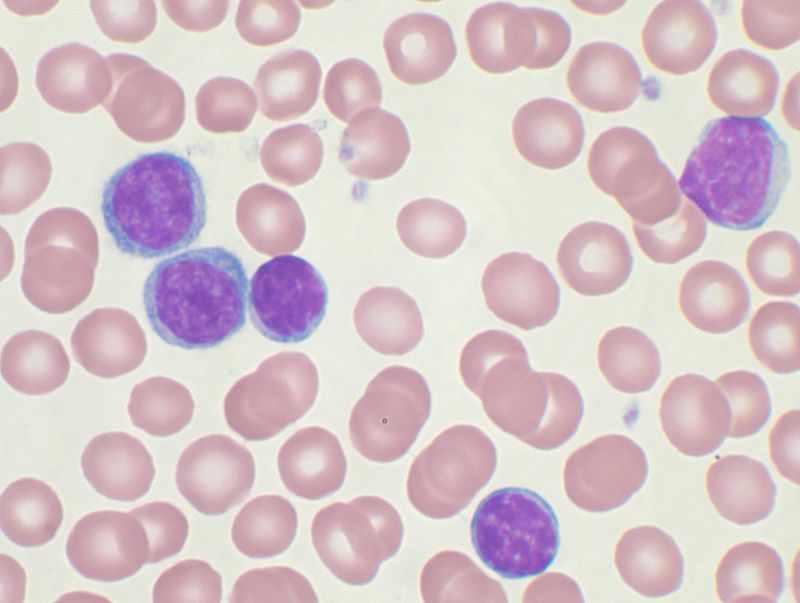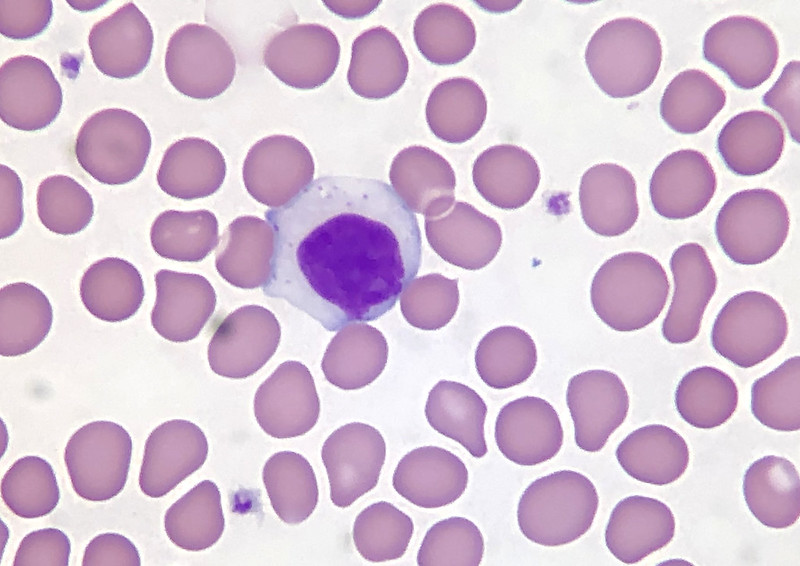What is the Difference Between B Cell and T Cell Leukemia
The key difference between B cell and T cell leukemia is that B cell leukemia is a group of lymphoid leukemia that affects B cells, while T cell leukemia is a group of lymphoid leukemia that affects T cells.
Lymphoid leukemias are a group of leukemias affecting circulating lymphocytes or white blood cells such as B cells and T cells. Lymphoid leukemias are closely related to lymphomas of lymphocytes. According to WHO classification, lymphoid leukemias can be divided based on the cells affected: B cell leukemia, T cell leukemia, and NK cell leukemia. Moreover, the most common type of lymphoid leukemia is B cell chronic lymphocytic leukemia.
CONTENTS
1. Overview and Key Difference
2. What is B Cell Leukemia
3. What is T Cell Leukemia
4. Similarities – B Cell and T Cell Leukemia
5. B Cell vs T Cell Leukemia in Tabular Form
6. Summary – B Cell vs T Cell Leukemia
What is B Cell Leukemia?
B cell leukemia is a group of lymphoid leukemia that affects B cells. B cell leukemia includes several different types of lymphoid leukemias that affect B cells, including B cell chronic lymphocytic leukemia, precursor B cells lymphoblastic leukemia, acute lymphoblastic leukemia, B cell prolymphocytic leukemia, and hairy cell leukemia. These leukemias can be identified in both children and adults. The most common type of B cell leukemia is B cell chronic lymphocytic leukemia. It accounts for 30% of all leukemias. B cell chronic lymphocytic leukemia occurs in adults. The other common type of B cell leukemia is precursor B cells lymphoblastic leukemia, which predominantly affects children and is less common in adults.

Symptoms of B cell chronic lymphocytic leukemia include enlarged, painless lymph nodes, fatigue, fever, pain in the upper left portion of the abdomen due to an enlarged spleen, night sweats, weight loss, and frequent infections. It is caused by mutations in the DNA-producing cells. B cell chronic lymphocytic leukemia can be diagnosed through blood tests, bone marrow biopsy and aspiration, CT scan, and PET scan. Chemotherapy, targeted drug therapy, immunotherapy, and bone marrow transplant are some treatment options for B cell chronic lymphocytic leukemia.
What is T Cell Leukemia?
T cell leukemia is a group of lymphoid leukemia that affects T cells. T cell leukemia includes several different types of lymphoid leukemias that affect T cells, including precursor T cell lymphoblastic leukemia, large granular lymphocytic leukemia, adult T cell leukemia, and T cell prolymphocytic leukemia. The most common type of T cell leukemia is precursor T cell lymphoblastic leukemia, which accounts for 15% of acute leukemias in childhood. However, precursor T cell lymphoblastic leukemia is most common in adolescent males. Its morphology is very similar to that of precursor B cell lymphoblastic leukemia. Precursor T cell lymphoblastic leukemia shows symptoms such as anemia, weakness, tiredness, shortness of breath, lightheadedness, palpitation, frequent infections, fever, malaise, sweats, purpura, nose bleeds, bleeding gums, bleeding, and bruising. It is highly associated with NOTCH1 (NOTCH homolog 1 gene) mutations.

Moreover, Precursor T cell lymphoblastic leukemia can be diagnosed through blood tests, bone marrow biopsy, chest X-ray, ultrasound, CT scan, MRI scan, and lumbar puncture. Furthermore, treatments for precursor T cell lymphoblastic leukemia include chemotherapy, radiation therapy, and stem cell transplant.
What are the Similarities Between B Cell and T Cell Leukemia?
- B cell and T cell leukemia are two groups of lymphoid leukemias.
- Both leukemia groups are closely related to lymphomas of lymphocytes.
- They are due to DNA mutations in blood-producing cells.
- Both leukemia groups affect children as well as adults.
- Some B cell leukemia and T cell leukemia are very similar in morphology.
- They are treated through chemotherapy and bone marrow transplant.
What is the Difference Between B Cell and T Cell Leukemia?
B cell leukemia is a group of lymphoid leukemia that affects B cells, while T cell leukemia is a group of lymphoid leukemia that affects T cells. Thus, this is the key difference between B cell and T cell leukemia. Furthermore, B cell leukemia is more common than T cell leukemia.
The below infographic presents the differences between B cell and T cell leukemia in tabular form for side-by-side comparison.
Summary – B Cell vs T Cell Leukemia
B cell and T cell leukemia are two groups of lymphoid leukemias. B cell leukemia is a group of lymphoid leukemia that affects B cells, while T cell leukemia is a group of lymphoid leukemia that affects T cells. so, this summarizes the difference between B cell and T cell leukemia.
Reference:
1. “B-Cell Chronic Lymphocytic Leukemia.” An Overview | ScienceDirect Topics.
2. “T-Cell Acute Lymphoblastic Leukaemia.” Leukaemia Care, 31 Jan. 2022.
Image Courtesy:
1. “Chronic lymphocytic leukemia” By VashiDonsk at the English Wikipedia (CC BY-SA 3.0) via Commons Wikimedia
2. “T-Cell Large Granular Lymphocytic Leukemia” By Ed Uthman (CC BY 2.0) via Flickr
ncG1vNJzZmivp6x7pbXFn5yrnZ6YsqOx07CcnqZemLyue9ahmK1lmah6tbTEZpuinpaav6a6wp5km52krLKmuoybZJydnKF6orrDZqtmm5WhuW64xK6inqWZlnw%3D